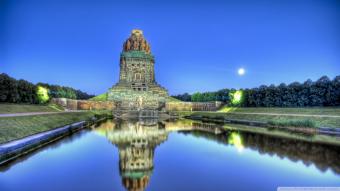
By Sean Mahon
Posted: 27th May 2014 11:57
As the birthplace of Wagner, and former residence of Bach, Leipzig is a place fully immersed in culture. An up and coming destination in East Germany, it offers an alternative to Berlin and is buzzing with dynamism thanks to its throbbing nightlife and stylish lifestyle. It is also the perfectly sized for a weekend escape, allowing you to absorb all the sites and experience just exactly what makes this destination such an attractive location.
Pristine architecture lines the streets of Leipzig, each building reflecting a different era. The Church of St Nicholas, or Nikolaikirche, for example was founded in 1165. Adorned with a striking Romanesque architecture, it was extended and redesigned into a Gothic hall in the early 16th Century. Dedicated to St Nicholas, medieval patron saint of merchants and wholesalers, the interior of the church is truly breathtaking thanks to its palm-like pillars and cream coloured pews.
Leipzig’s historical importance is not isolated to the key figures associated with the area such as Bach or Wagner. The city became known as the ‘Stadt der Helden’ (City of Heroes) because of the part it played in the 1989 ‘Peaceful Revolution’. The revolution saw residents organise protests against the communist regime which eventually saw hundreds of thousands take to the streets and herald the end of the Cold War.
Leipzig has a proud musical heritage which is still very much celebrated today; one of the world's top classical bands, the Gewandhausorchester, and one of the oldest and finest boys’ choirs, the 800-year-old Thomanerchor, continues to routinely delight audiences. There is even a recently developed tourist trail known as ‘Leipziger Notenspur’ which joins key sites in the city's musical past. It is not only music that has thrived in Leipzig however; in recent years, the art scene has blossomed, particularly under the careful cultivation of the neo-realistic New Leipzig School; for over 10 years, the school has been creating waves in the international art world with works by such protagonists as Neo Rauch and Tilo Baumgärtel.
It is nearly impossible to escape the Mädlerpassage in Leipzig; it is quite simply Germany’s most stunning shopping arcade. Inspired by the neo- Renaissance and Art Nouveau, it originally served as a trade hall in 1914, but its history can be traced as far back as 1525; two businessmen opened a wine bar in the region and then erected an exhibition hall after witnessing its popularity. It was renovated in the early 1990s and today it is home to shops, bars and restaurants. The statues of Faust and Mephistopheles stand at the Grimmaische Strasse; do not forget to touch the foot of Faust for luck!
What makes Leipzig so appealing is its general compactness, as many of the city’s main attractions can be found in the centre. Towering over the main square is the wondrous Renaissance Rathaus, a colossal and uncompromising building which has become a common appearance in many German cities. The atmosphere is not as architecturally indebted like other Eastern cities in Europe. Eighteenth-century relics are cancelled out by 1960s office blocks. The city itself is relatively relaxed and animated, making it a many-layered city.
For those seeking historical enrichment, head towards the Zeitgeschichtliches Forum, a museum which has recorded the GDR period. The grainy newsreels of the 1950s and 1960s offer a real insight into what was a bleak period for the city and how it confidently embraced its vibrant, modern identity. The museum also celebrates some of the poets and musicians and political trouble-makers who agitated the system in the hope that a better way of life would prevail. Equally interesting and intriguingly harrowing is the Runde Ecke building, which for many years stood as a tool of oppression in the former East Germany Stasi Headquarters. There is a permanent exhibition on the organisation entitled Macht und Banalitat - Power and Banality, which takes a look at the structure and methods of the GDR’s secret police.



Comments